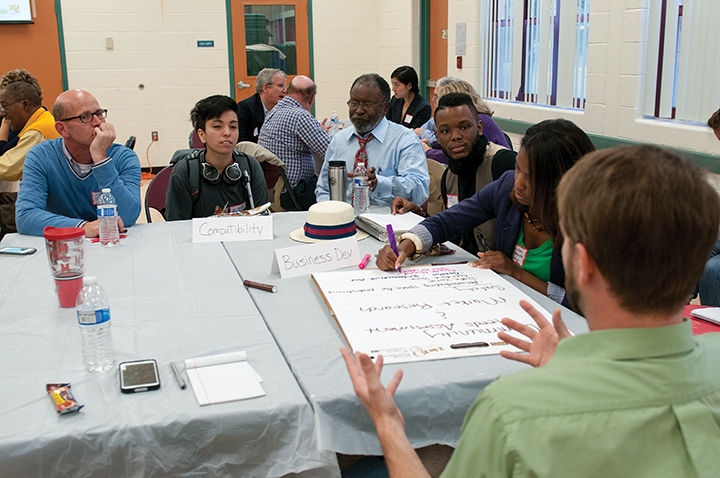
People talk in small groups at the College Park Think-a-Thon, a collaborative event which addressed how to bring art and culture to the Route 1 area, hosted in The College Park Community Center on Saturday, October 11, 2014.
Members of this university and city community came together Saturday to offer ideas for the cultural and artistic redesign of Route 1 as part of a collaborative effort that aims to turn the city into a top-20 college town by 2020.
A group of about 40 people, consisting of university administrators, city officials, local artists, residents and students, gathered at the College Park Community Center for the afternoon to brainstorm ways the arts can be used to improve the city’s aesthetic appeal.
Popular ideas included open galleries and spaces for artists to display visual and verbal art, performance spaces and theaters, more parks and greenery and designated paths for bikers and pedestrians.
“We want to make life better for people who live here and work here and play here,” Mayor Andy Fellows said. ”In doing that, we’ll end up attracting people from different places, because with any cool community that has things to do, people from outside are going to want to come.”
Major revitalization efforts are already either planned or taking place along Route 1 — new safety signs, demolition of the Knox Boxes, construction of a four-star hotel and tree canopies to break up miles of pavement — but Sheri Parks, the associate dean for research of interdisciplinary scholarship and programming for the arts and humanities college, said there is a lot of space for additional ideas.
This type of event, which took place at the university level on Sept. 12 at the Clarice Smith Performing Arts Center, is a way of gaging what the university and local community want those ideas to be, Parks said. Students and city residents seem to want the same thing: a vibrant, social and stimulating town.
“[People] want places where they can sit, where they can talk, where they can hear live music or they can hear spoken word or they can exchange ideas … a friendly, pretty, safe, walkable but intellectually interesting space,” Parks said. “Nobody wants there to be a strip mall down Baltimore Avenue.”
During the event, attendees broke into specialized groups to brainstorm projects that could improve the city through art and culture.
Those who discussed ideas for children and families said they sought projects such as weekly rotating arts programs — music, robotics, drawing and other art forms — that would help link the community.
“It could be rotating around to different parts of the city at different times,” said Mary Sies, an American studies professor. “There would be a product produced every week, and visiting artists from the city could come in and help sort of lead instruction.”
Those tasked with discussing business development and compatibility expressed a need for a diversity of businesses and shops to appeal to people of all ages, not just college students.
Those in the scale and infrastructure and “streetscape” groups focused heavily on aesthetics. The first group suggested breaking Route 1 into sections with recognizable themes, while the second discussed not only adding more trees to help with local flooding, but also making things such as streetlights and garbage cans works of art rather than simply utilitarian objects.
“There are artists that create art on public objects, like a garbage can, to make art accessible to everyone,” said Mariko Terasaki, a public policy graduate student who attended the event. “It’s not like art should be seen in museums only.”
Omar Blaik, the founder and CEO of advisory firm U3 Ventures, which is collaborating with the university and city on projects such as the Route 1 hotel, believes the city will thrive on these unique ideas.
“We think that great cities are not made of big projects; they’re made of small, kind of unique projects,” Blaik said. “We don’t want to create Main Street — anywhere, America. We want to create something in College Park that is much more of College Park and the University of Maryland.”
Because many of these ideas are new, sources of funding have yet to be determined, Fellows said. He said state and local money, whether through investors in the private sector or the city itself, along with city and county taxpayers, often help fund these types of projects.



